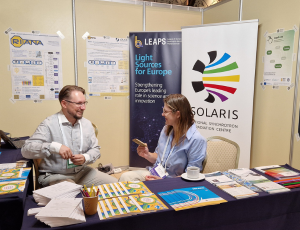 Web Content Display
Web Content Display
SOLARIS centre
 Web Content Display
Web Content Display
The first users of the POLYX beamline!
Dr. Anna Lipińska, dr. Adam Ćmiel (Institute of Nature Conservation PAS), prof. Larysa Shevchuk (State University of Zhytomyr Polytechnic, Ukraine) and Lillia Bylyna (Berdychiv Medical College, Ukraine) conducted the first research on a POLYX beamline, studying bivalves mollusks of the family Sphaeriidae, which are important components of freshwater ecosystems because they are natural filterers and purify water by passing it through their gills.
POLYX beamline
The POLYX is a compact beamline for multimodal X-ray imaging and spectromicroscopy. With available techniques, researches can obtain spatial information about the internal structure of the object, as well as elemental composition and chemical compounds in investigated samples. The beamline will be used for research in physics, chemistry, biological sciences, material engineering, chemical engineering, medical engineering, environmental engineering, electronics, archaeology and cultural heritage research.
Can you explain what your research is about?
- Freshwater mussels are among the most endangered animal groups on the planet, requiring immediate conservation efforts. The project we are currently working on aims to investigate the reproduction process of mussels from the Sphaeriidae family. Understanding their reproductive strategy will enable us to artificially breed mussels and, in the future, reintroduce them into natural habitats. We hope that our research will become a part of a conservation and preservation program for these species, explains Prof. Larysa Shevchuk (State University of Zhytomyr Polytechnic, Ukraine)
- Mussels from the Sphaeriidae family are a particularly interesting example of mollusks due to their unique reproductive system. They are hermaphrodites that develop their offspring in so-called marsupia located in their gills until the juvenile individuals are released. This reproductive system, based on successive generations ("matryoshka"), is highly atypical and previously unknown, making it of great importance in terms of evolutionary biology and nature conservation. This strategy appears to be responsible for their exceptional abundance in certain bodies of water. A key element of their reproductive strategy, which has been completely underestimated in previous research, is the ability to hatch multiple generations within a single life cycle. This phenomenon allows for rapid reproduction through parthenogenesis and actively enhances the ecological benefits of this group. It is a completely new and poorly studied phenomenon, even in the context of evolutionary biology, so it is unclear what determines this strategy and how far it is planned. It seems that it is not only a response to a low number of individuals in the population (which would justify parthenogenesis), but also the existence of massive populations (e.g., with densities exceeding several thousand individuals per square meter, which is common in populations of this species in Ukraine, where this phenomenon has been observed) is a result of adopting this highly effective reproductive strategy. Understanding the mechanism of this phenomenon would not only enable the protection of this group of animals but also the active restoration of their presence and associated ecosystem services, says Dr. Anna Lipińska (Institute of Nature Conservation, Polish Academy of Sciences).
What would you like to achieve with your research?
- We plan to count the number of juveniles inside each adult collected. It is planned to collect 100 adults. We intend to check the contents of the gill cavities of the test specimens, and we expect that the imaging will show, in a qualitative and quantitative way, the presence of juveniles. We will also measure the body size of identified juveniles, including the length and width of their shells. These are preliminary studies and serve as an introduction to extensive research on the reproductive system of mussels from the Sphaeriidae family," explains Dr. Adam Ćmiel (Institute of Nature Conservation, PAN).
Why did you decide to conduct your research at the SOLARIS Centre?
Dr. Lipińska explains - Traditional methods (i.e. the use of an optical microscope) do not give satisfactory results in this case (no possibility of non-invasive examination of the inside of the body of individuals), we planned to use the POLYX beamline, which allows imaging of the 3D structure and distribution of elements in the examined samples.
The POLYX beamline is currently in the final commissioning phase. This means that the beamline team perform the first test measurements, while improving and calibrating all elements of the beamline (optics, detectors, stepper and piezo motors, etc.) to achieve the assumed parameters of the beamline (i.e. resolution). The first users used the POLYX beamline as part of the so-called expert commissioning access and thanks to that, the team was able to test the X-ray imaging performance on real samples (mussels from the Sphaeriidae family) and make appropriate adjustments to the calibration of the experimental system of the beamline. As a result, researches obtained two-dimensional radiographies of mussels that will help users identify samples of interest to them. In the future, for selected specimens, it will be possible to perform X-ray microtomography.
Figure 1. Radiography of mussels of the Sphaeriidae family composed of 5x3 radiography of individual fragments of mussels.
The photo shows (from the left): Lillia Bylyna, Prof. Paweł Korecki, Dr Katarzyna Sowa, Dr Anna Lipińska, Prof. Larysy Shevchuk, Dr Adam Ćmiel, Dr. Eng. Tomasz Kołodziej.
The material was created thanks to the cooperation of: Dr. Anna Lipińska, Dr Adam Ćmiel Prof. Larysa Shevchuk, Lillia Bylyna, Dr Katarzyna Sowa and Prof. Paweł Korecki.



